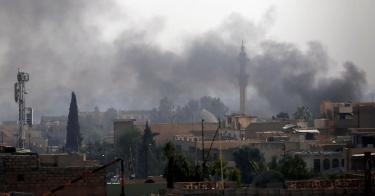More than a decade and a half into a war against a global Islamist terrorist threat that endangers both the United States and many of its allies, Washington is still having trouble describing what it’s fighting.
The Obama administration favored a generic approach. It tried to cleave terrorists from the religion they profess, describing efforts to combat radicalization as “countering violent extremism,” a phrase often shortened to CVE. Indeed, many of the programs the government conducted or promoted under Obama’s watch discouraged discussions of Islamist-related terrorism.
That solved exactly nothing. The general public has no idea what a bureaucrat’s talking about when he mentions CVE, and it’s hard to fight a war of ideas if there’s no focus on the idea. That would be like trying to win the Cold War without ever mentioning communism.
The Trump administration ought to rethink our approach from top to bottom.
First, the U.S. government ought to get over its fear of labeling extremist political movements and terrorists as Islamists. The term is not a pejorative short-hand for Muslims we don’t like. In the modern era, the term has always been meant to infer a political movement that argued it was based on a particular interpretation of religious concepts. When the goals of such a movement are tied to anti-democratic methods, violence and terrorism, labeling the group “Islamist” is simply a matter of accuracy.
Second, dump the term CVE. It’s an awkward label that does little to explain our government’s efforts.
Third, revisit CVE-era domestic programs. America’s radicalized population — comprising every individual who has plotted a terrorist attack or been convicted of providing material support to terrorism since 9/11 — amounts to 1,000 individuals. That’s out of a total population of 320 million. Domestic efforts ought to be focused on traditional counter-terrorism operations that have proven most effective at stopping and thwarting attacks.
Further, the government ought to put more effort into examining subversive political movements such as American affiliates of the Muslim Brotherhood. My Heritage Foundation colleague Robin Simcox has rightly called for “an up-to-date review of the Brotherhood’s strategy in the U.S. and ideological or operational ties to American groups . to ensure that the U.S. government does not fund or engage with groups and charities tied to the Muslim Brotherhood.”
Fourth and finally, our overseas programs should fit their surroundings. The Islamic State and al-Qaeda have global footprints, but their influence looks very different in different parts of the world. The U.S. doesn’t need a universal label for what should be a plethora of discrete and crafted activities dealing with a global-but-disparate Islamist threat.
What the U.S. does to support freedom and democracy in Tunisia might, for example, look very different from efforts to get Pakistan to discredit the Haqqani network.
As master general Sun Tzu once wrote, “If you know the enemy and know yourself, you need not fear the result of a hundred battles.”
It’s time to jettison the CVE label — and be honest about who and what we’re fighting.
This piece originally appeared in he Boston Herald




